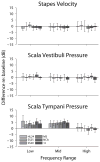Cochlear Implant Electrode Effect on Sound Energy Transfer Within the Cochlea During Acoustic Stimulation
- PMID: 26333018
- PMCID: PMC4575243
- DOI: 10.1097/MAO.0000000000000838
Cochlear Implant Electrode Effect on Sound Energy Transfer Within the Cochlea During Acoustic Stimulation
Abstract
Hypothesis: Cochlear implants (CIs) designed for hearing preservation will not alter mechanical properties of the middle and inner ears as measured by intracochlear pressure (P(IC)) and stapes velocity (Vstap).
Background: CIs designed to provide combined electroacoustic stimulation are now available. To maintain functional acoustic hearing, it is important to know if a CI electrode can alter middle or inner ear mechanics because any alteration could contribute to elevated low-frequency thresholds in electroacoustic stimulation patients.
Methods: Seven human cadaveric temporal bones were prepared, and pure-tone stimuli from 120 Hz to 10 kHz were presented at a range of intensities up to 110 dB sound pressure level. P(IC) in the scala vestibuli (P(SV)) and tympani (PST) were measured with fiber-optic pressure sensors concurrently with VStap using laser Doppler vibrometry. Five CI electrodes from two different manufacturers with varying dimensions were inserted via a round window approach at six different depths (16-25 mm).
Results: The responses of P(IC) and VStap to acoustic stimulation were assessed as a function of stimulus frequency, normalized to sound pressure level in the external auditory canal, at baseline and electrode-inserted conditions. Responses measured with electrodes inserted were generally within approximately 5 dB of baseline, indicating little effect of CI electrode insertion on P(IC) and VStap. Overall, mean differences across conditions were small for all responses, and no substantial differences were consistently visible across electrode types.
Conclusion: Results suggest that the influence of a CI electrode on middle and inner ear mechanics is minimal despite variation in electrode lengths and configurations.
Conflict of interest statement
Stephen P. Cass is a consultant on the Surgical Advisory Board for Cochlear Corporation.
James R. Easter is an employee at Cochlear Boulder LLC.
Figures





Similar articles
-
Stapes displacement and intracochlear pressure in response to very high level, low frequency sounds.Hear Res. 2017 May;348:16-30. doi: 10.1016/j.heares.2017.02.002. Epub 2017 Feb 9. Hear Res. 2017. PMID: 28189837 Free PMC article.
-
Frequency dependence and harmonic distortion of stapes displacement and intracochlear pressure in response to very high level sounds.Hear Res. 2024 Nov;453:109121. doi: 10.1016/j.heares.2024.109121. Epub 2024 Sep 20. Hear Res. 2024. PMID: 39332208
-
Comparison of forward (ear-canal) and reverse (round-window) sound stimulation of the cochlea.Hear Res. 2013 Jul;301:105-14. doi: 10.1016/j.heares.2012.11.005. Epub 2012 Nov 14. Hear Res. 2013. PMID: 23159918 Free PMC article.
-
An overview of cochlear implant electrode array designs.Hear Res. 2017 Dec;356:93-103. doi: 10.1016/j.heares.2017.10.005. Epub 2017 Oct 18. Hear Res. 2017. PMID: 29102129 Review.
-
Tissue resistivities determine the current flow in the cochlea.Curr Opin Otolaryngol Head Neck Surg. 2006 Oct;14(5):352-5. doi: 10.1097/01.moo.0000244195.04926.a0. Curr Opin Otolaryngol Head Neck Surg. 2006. PMID: 16974151 Review.
Cited by
-
Intracochlear Sound Pressure Measurements in Normal Human Temporal Bones During Bone Conduction Stimulation.J Assoc Res Otolaryngol. 2018 Oct;19(5):523-539. doi: 10.1007/s10162-018-00684-1. Epub 2018 Aug 31. J Assoc Res Otolaryngol. 2018. PMID: 30171386 Free PMC article.
-
Wideband Acoustic Immittance in Cochlear Implant Recipients: Reflectance and Stapedial Reflexes.Ear Hear. 2020 Jul/Aug;41(4):883-895. doi: 10.1097/AUD.0000000000000810. Ear Hear. 2020. PMID: 31688195 Free PMC article.
-
Effect of Cochlear Implantation on Vestibular Evoked Myogenic Potentials and Wideband Acoustic Immittance.Ear Hear. 2020 Sep/Oct;41(5):1111-1124. doi: 10.1097/AUD.0000000000000831. Ear Hear. 2020. PMID: 32032225 Free PMC article.
-
A Comparison of Intracochlear Pressures During Ipsilateral and Contralateral Stimulation With a Bone Conduction Implant.Ear Hear. 2020 Mar/Apr;41(2):312-322. doi: 10.1097/AUD.0000000000000758. Ear Hear. 2020. PMID: 31389846 Free PMC article.
-
Electrode Montage for Bilateral Cervical Vestibular-Evoked Myogenic Potential Testing.J Am Acad Audiol. 2024 Jul;35(7-08):165-171. doi: 10.1055/a-2250-3096. Epub 2024 Jan 19. J Am Acad Audiol. 2024. PMID: 38242168 Free PMC article.
References
-
- Clark GM. The multi-channel cochlear implant: Multi-disciplinary development of electrical stimulation of the cochlea and the resulting clinical benefit. Hear Res. 2014 - PubMed
-
- Gantz BJ, Turner CW. Combining acoustic and electrical hearing. Laryngoscope. 2003;113:1726–30. - PubMed
-
- von Ilberg C, Kiefer J, Tillein J, et al. Electric-acoustic stimulation of the auditory system. New technology for severe hearing loss. ORL J Otorhinolaryngol Relat Spec. 1999;61:334–40. - PubMed
-
- Turner CW, Gantz BJ, Vidal C, et al. Speech recognition in noise for cochlear implant listeners: benefits of residual acoustic hearing. J Acoust Soc Am. 2004;115:1729–35. - PubMed
-
- Balkany TJ, Connell SS, Hodges AV, et al. Conservation of residual acoustic hearing after cochlear implantation. Otology & Neurotology. 2006;27:1083–8. - PubMed
Publication types
MeSH terms
Grants and funding
LinkOut - more resources
Full Text Sources
Medical
Miscellaneous

